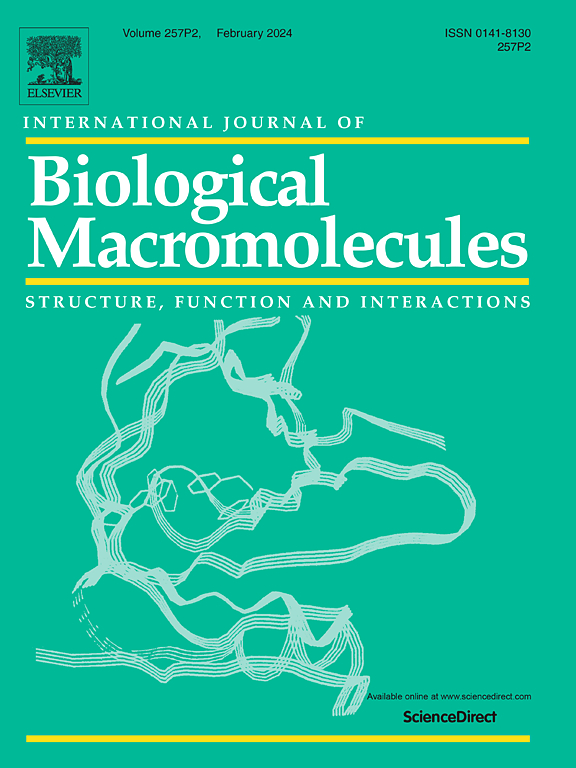环氧氯丙烷交联壳聚糖对活性红2染料的吸附:优化及吸附机理
IF 8.5
1区 化学
Q1 BIOCHEMISTRY & MOLECULAR BIOLOGY
International Journal of Biological Macromolecules
Pub Date : 2025-07-22
DOI:10.1016/j.ijbiomac.2025.146202
引用次数: 0
摘要
含化学染料废水的直接排放严重影响人体健康。本文制备了新型交联壳聚糖微球,用于化学合成染料的吸附。对制备的壳聚糖珠进行了一系列表征和吸附性能测试。并对吸附条件进行了优化。此外,还研究了吸附剂的吸附机理、动力学、热力学和吸附模型。交联壳聚糖珠具有规则的形状和均匀的大小。表面有多个氨基和羟基。结果表明,环氧氯丙烷提高了壳聚糖的吸附率和可重复利用性。交联壳聚糖珠对RR2染料的吸附是自发的。吸附过程为物理吸附和化学吸附。在最佳吸附条件(T = 303 K, pH = 3,染料浓度55 mg/L,吸附剂剂量50 mg)下,交联壳聚糖珠ECS1对RR2染料的最大吸附量为485.1 mg/g。计算了吸附剂的吸附热力学,ΔH0和ΔS0分别为−41.22 kJ/mol和−0.103 kJ/mol·K。ecs1表面含有丰富的氨基、羟基和杂原子(N和O)。静电力、氢键和n-π相互作用促进了RR2分子的吸附。本文章由计算机程序翻译,如有差异,请以英文原文为准。

Epichlorohydrin cross-linked chitosan for adsorption of reactive red 2 dye: Optimization and adsorption mechanism
The direct discharge of wastewater containing chemical dyes seriously affects human health. Here, we prepared novel adsorbent cross-linked chitosan beads for adsorption of chemically synthesized dyes. The prepared chitosan beads were tested for a series of characterization and adsorption properties. The adsorption conditions were also optimized. In addition, the adsorption mechanism, kinetics, thermodynamics and adsorption modelling of the adsorbent were investigated. The cross-linked chitosan beads have a regular shape and uniform size. The surface has a plurality of amino and hydroxyl groups. The results showed that epichlorohydrin increased the adsorption rate and reusability of chitosan. Adsorption of RR2 dye by cross-linked chitosan beads was spontaneous. The adsorption process was both physisorption and chemisorption. Under the optimal adsorption conditions (T = 303 K, pH = 3, dye concentration 55 mg/L, 50 mg of adsorbent dose), the maximum adsorption of RR2 dye by crosslinked chitosan beads ECS1 was 485.1 mg/g. The adsorption thermodynamics of the adsorbent was calculated and ΔH0 and ΔS0 were −41.22 kJ/mol and −0.103 kJ/mol·K, respectively. The surface of ECS 1 is rich in amino groups, hydroxyl groups and heteroatoms (N and O). The adsorption of RR2 molecules is facilitated by electrostatic forces, hydrogen bonding and n-π interactions.
求助全文
通过发布文献求助,成功后即可免费获取论文全文。
去求助
来源期刊
CiteScore
13.70
自引率
9.80%
发文量
2728
审稿时长
64 days
期刊介绍:
The International Journal of Biological Macromolecules is a well-established international journal dedicated to research on the chemical and biological aspects of natural macromolecules. Focusing on proteins, macromolecular carbohydrates, glycoproteins, proteoglycans, lignins, biological poly-acids, and nucleic acids, the journal presents the latest findings in molecular structure, properties, biological activities, interactions, modifications, and functional properties. Papers must offer new and novel insights, encompassing related model systems, structural conformational studies, theoretical developments, and analytical techniques. Each paper is required to primarily focus on at least one named biological macromolecule, reflected in the title, abstract, and text.

 求助内容:
求助内容: 应助结果提醒方式:
应助结果提醒方式:


